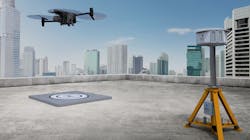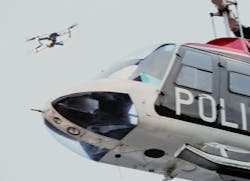The Transformation of Drone First Responder: DFR 2.0
But the future of DFR seeks to eliminate the need for rooftop personnel, or VOs, entirely, simplifying the process into a single-person teleoperation and enabling true BVLOS operations. This isn't a distant dream but is gradually being realized thanks to innovative airspace monitoring solutions.
So, what's the buzz around BVLOS? BVLOS is a critical concept in the commercial and public sector drone community. It refers to the ability to operate drones beyond the operator's immediate line of sight, through a combination of onboard cameras and autonomous operations.
Current DFR BVLOS operations require the RPIC or VO to maintain observation of a two mile operational volume around the area of the drone operation, and not necessarily the drone itself. This requires two personnel for operations, which many smaller organizations find difficult to provide. Technology was needed to remove the personnel stationed on the roof and allow a single operator to control missions.
Game changing advanced radar, optical, and acoustic technologies are now emerging, such as Ground-Based Surveillance Systems (GBSS), to enable BVLOS operations, with fewer personnel needed. It holds the promise of longer, uninterrupted drone operations, be it for first responder operations, utility inspections, drone deliveries or other commercial deployments. Achieving BVLOS dramatically improves speed, efficiencies, and costs - all critical factors for first responders.
DFR 2.0 represents the next generation of Drone as First Responder operations, moving away from traditional roof-based operations managed by an RPIC. It incorporates advanced features such as "drone in a box," automating the Unmanned Aerial System (UAS) launch, recovery, and battery charging. It also integrates electronic GBSS such as radar, optical, or acoustic—alongside Advanced Detection Systems Broadcast (A-DSB) from general aviation and commercial aircraft.
With this new technology, whether it’s radar, optical, or acoustic detection, tools are being used independently or fused together to create powerful airspace monitoring solutions that enable BVLOS operations. GBSS devices can be strategically placed on rooftops, poles, cellular towers, or other tall structures.
DFR 2.0 streamlines emergency response by converting DFR into a single-operator program. It uses GBSS Detect and Avoid (DAA) technology to alert the teleoperator about any intruding aircraft in real-time, giving the teleoperator ample time to perform a deconfliction maneuver or the UAS to execute an automated, pre-programmed deconfliction maneuver based on DAA system inputs.
Currently, Pearland PD in Texas is the only police agency to obtain a Part 91.113 waiver to conduct this type of operation and is the lead in testing this emerging technology.
Obtaining FAA Waivers
To obtain an FAA BVLOS waiver, there are several questions a first responder organization must consider.
First, the FAA mandates that your agency holds a valid CFR 14 Part 91 COA (Certificate Of Authorization) before submitting a BVLOS COA application. Is your organization already operating a UAS program with comprehensive policies and procedures in place? For those looking to set up a foundational UAS program, "The Five C’s: Principles on the Responsible Use of Drones by Public Safety Agencies" (by DroneResponders & Skydio, 2020) offers insightful guidance. The core principles include:
- Community Engagement and Transparency
- Civil Liberties and Privacy Protection
- Common Operating Procedures
- Clear Oversight and Accountability
- Cybersecurity
Any organization, public or private, should consider these principles in developing their UAS programs. For more details go to https://www.droneresponders.org/the-five-cs.
After obtaining the PART 91 COA and ensuring both public and organizational support, the next step involves transitioning your organization to BVLOS operations under an FAA COA, which raises further questions. For instance, are you aiming for a BVLOS/DFR program similar to the “traditional” City of Chula Vista model, where the RPIC oversees the airspace from a rooftop and can assume control during emergencies from the teleoperator? Or are you considering a single-pilot operation, where the UAS is housed in a box solution and a GBSS technology is used to monitor the airspace, designating the teleoperator as the sole remote pilot?
It's not widely recognized that agencies can possess several COAs tailored for distinct operations. Consolidating various operations under a single COA isn't advisable as this could invite intensive scrutiny during the application phase. It's more strategic to segment operations. For instance, field operations with patrol deployed UASs might fall under a jurisdictional COA inclusive of TBVLOS (Tactical Beyond Visual Line of Sight), a limited form of BVLOS. BVLOS/DFR operations should ideally have their dedicated COA, so the safety and collision mitigation procedures can be evaluated for the specific operation.
For “traditional” DFR operations, the FAA has made the processes to obtain a Part 91.113 BVLOS COA a little easier, but still requires a detailed concept of operations and pre-application approval before you are authorized to submit your COA request.
The FAA now accepts two forms: a pre-application template form, First Responder Beyond Visual Line of Sight (FR-BVLOS) 91.113 Waiver REQUEST CONOPs, for BVLOS operations (Available here), That entails simply filling in the form, then a secondary form and FAA Form 7711-2, Application for Certificate of Waiver or Authorization (Available here). Both forms must be emailed to [email protected]. Once approval is received, the applicant may complete their formal application in the CAPS System, which is a topic worthy of its own article.
The momentum behind DFR programs continues rapidly, and the new era of single-operator DFR/BVLOS operations is within sight. For those in the thick of it, staying updated with FAA regulations, especially regarding BVLOS operations, is paramount. Embrace the evolving tech, stay informed, and here's to navigating the future of drones with safety and innovation at the forefront.
To learn more about the impact of DFR programs, read our February 20 blog:
https://matrixspace.com/advanced-intelligence-from-the-air-drone-as-a-first-responder/
Join us at the INTERPOL drone expert summit, October 23-24, 2023 at Chula Vista, CA to learn more. https://www.uasnorway.no/dfr/
About the Author
David brings 33 years of service with the City of Campbell Police Department, where he held a variety of critical roles, most recently leading the department’s DFR (drone as first responder) operations. He remains a Reserve Officer. As Field Services Engineer and lead UAS Pilot at MatrixSpace he drives the UAS-oriented solutions for this advanced radar company, which is revolutionizing radar applications across diverse industries.
About the Author

David Cameron
David brings 33 years of service with the City of Campbell Police Department, where he held a variety of critical roles, most recently leading the department’s DFR (drone as first responder) operations. He remains a Reserve Officer. As Field Services Engineer and lead UAS Pilot at MatrixSpace he drives the UAS-oriented solutions for this advanced radar company, which is revolutionizing radar applications across diverse industries.

